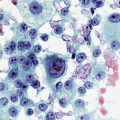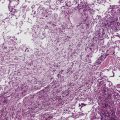Two types of drugs are used in the treatment of obstructive airway diseases:
- Relievers (bronchodilators) give immediate reversal of airway obstruction, largely by directly relaxing airway smooth muscle.
- Controllers (preventers) suppress the underlying disease process and provide long-term control of symptoms. These drugs include antiinflammatory treatments, such as corticosteroids.
Both asthma and COPD are characterized by airway narrowing secondary to a chronic inflammatory process. In asthma, eosinophilic (and sometimes neutrophilic) inflammation occurs throughout the respiratory tract, although the proximal airways are predominantly affected. In COPD, there is inflammation and narrowing of small airways (chronic obstructive bronchiolitis) and destruction of lung parenchyma (emphysema), resulting in loss of support for the airways, early closure on expiration, and air trapping.
Bronchodilators cause immediate reversal of airway obstruction as a result of a relaxing effect on airway smooth muscle. However, other pharmacologic effects of bronchodilator drugs on other airway cells (reduced microvascular leakage, reduced release of bronchoconstrictor mediators from inflammatory cells) may contribute to the reduction in airway narrowing. Three classes of bronchodilators are in current clinical use for the treatment of obstructive airway diseases: β2-agonists, theophylline, and anticholinergics.
β2-ADRENERGIC AGONISTS
Inhaled β2-agonists are the bronchodilator treatment of choice for patients with asthma because they are the most effective bronchodilators, reverse all known bronchoconstrictor mechanisms, and have minimal side effects when used correctly. Short-acting and nonselective β-agonists (e.g., isoproterenol) have no role.
Mode of Action
β2-Agonists produce bronchodilatation by directly stimulating β2-receptors on airway smooth muscle cells, which leads to relaxation of central and peripheral airways. β2-agonists act as “functional antagonists” and reverse bronchoconstriction irrespective of the contractile agent; this is important in asthma because many bronchoconstrictor mechanisms (neural and mediators) are likely to constrict airways. In COPD, their major effect is reversal of cholinergic neural tone. Occupation of β2-receptors by agonists results in the activation of adenylyl cyclase via the stimulatory G-protein (Gs), which increases intracellular cyclic AMP (cAMP), leading to relaxation through inhibition of the contractile machinery.
β2-receptors are localized to several types of airway cells, and β2-agonists may have additional effects. β2-agonists may cause bronchodilatation, not only by a direct action on airway smooth muscle but also indirectly by inhibiting the release of bronchoconstrictor mediators from mast cells and of bronchoconstrictor neurotransmitters from airway nerves. β2-agonists have an inhibitory effect on mast cell mediator release and microvascular leakage, suggesting they may inhibit acute inflammation. However, β2-agonists do not have a significant inhibitory effect on the chronic inflammation of asthmatic airways and do not reduce airway hyperresponsiveness, which is a clinical manifestation of inflammation in asthma.




